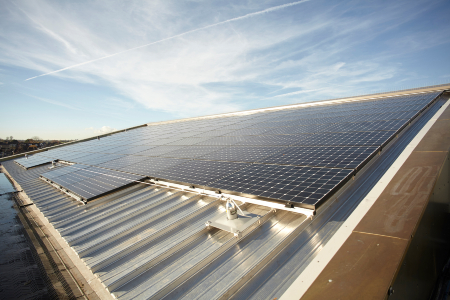Illustration showing a solar photovoltaic system.
1. Solar panels must be located on a predominantly south facing slope, ideally at an angle around 30 degrees. Shallower angles and orientations away from south can be implemented, thought this will incrementally reduce the efficiency of the array.
2. The roof of your building may require strengthening locally to accommodate them and you should consider safe access for installation and cleaning. If they are mounted at more than a 15 degree angle, they are mostly self-cleaning. They also need to be inspected for cracks. We suggest doing this every other year.
Solar Photovoltaic (PV) systems use energy from solar radiation to generate. This can be supplied directly to the home or via a connector to the national grid.
Large scale solar photovoltaic installation.
Solar thermal, on the other hand, uses sunlight to heat a fluid. Depending on the particular application, it can be water or a water/glycerol mixture.
Solar PV has a big advantage over solar thermal in that it generates electricity, whereas solar thermal is dedicated to heating water or air.
Solar panel installations (both PV and thermal) can be sited anywhere as long as it does not regularly get overshadowed. This includes:
- free-standing in the garden
- on the roof of a property, garage, or outbuilding
Recent technological advancements in this field have led to the development of solar tiles and transparent solar PV. These are more discreet options than traditional solar PV, which provide more opportunities to improve a building’s energy efficiency. These technologies are particularly relevant for listed/historic buildings, which may experience more difficulty when looking to install traditional solar PV.
The upfront costs of both thermal and solar PV vary significantly depending on the type of system chosen and the area of roof covered. While the upfront costs of both are usually high, the energy and electricity bill savings can be significant, meaning that you will usually reach a break-even point, in terms of cost, between 12-20 years.
The payback time on the investment for solar thermal tends to be quicker than for solar PV.
Potential issues to be aware of
Whilst the installation of solar panels on residential buildings may be ‘permitted development’ in certain circumstances, wildlife legislation still applies. Relevant legislation is as follows:
-
All species of bat and their roosts are protected under both the Wildlife and Countryside Act 1981 (as amended) and the Conservation of Habitats and Species Regulations 2010 (as amended).
-
All wild birds are protected by the Wildlife and Countryside Act 1981 (as amended), which protects the birds themselves, their eggs and nests whilst being built.
Raised slates/tiles provide suitable opportunities for roosting bats as well as nesting birds, fitting solar panels may cause harm or disturbance to them. Other retrofitting options such as cavity wall insulation, solar thermal, externally applied solid wall insulation, roof insulation at rafter level and timber casement window draught proofing may also affect ecology, as such the potential presence of protected species requires careful consideration. If retrofitting is planned within or adjacent to known nesting swift sites, then extra caution will be required.
In addition, the broad location of known swift nesting sites can be found on our maps;
Listed Building Consent is required for PV roof slates and solar panels on listed buildings, and any buildings within their curtilage.
Solar tiles should be of a similar colour and appearance to the original tiles.
Solar slates can also be installed. These look like natural, traditional roof tiles and generate clean electricity.
PV tiles are often more likely to be acceptable on more modern listed buildings and where the roof is not highly visible from any vantage point.
A discreet location will be a determining factor for successful installation for instance behind parapets and within other hidden areas of a roof.
PV tiles have a different appearance to panels, and their visual impact can depend on how much of the roof is covered.
It is more desirable to locate panels off the building where space permits within the grounds of the building.
If considering recessed panels, consideration should be given to the loss of historic fabric where the roofing material is historic and significant.
Consideration should be given to the weight of solar panels and an assessment of the roof structure should be undertaken by a structural engineer.
Evacuated tube solar thermal systems are more visible than flat-plate panels. However, they require less space, and can be well suited to flat roofs.
Fixings should cause no damage to significant historic fabric.
Where a flat roof has a lead covering, a specialist lead contractor should be consulted.
Ensure there is a supply of replacement matching stone/ handmade tiles before the work proceeds, in case of damage.
We support the use of solar PV and solar thermal where appropriate.
In the light of the Climate Emergency, we will generally permit and encourage alterations on listed buildings, with special regard to the the following:
- Preserving the building, its setting or any features of special architectural or historic interest which it possesses
- Preserving or enhancing the character of a conservation area
- Respecting the significance of any non-designated heritage asset
Increased clarity on solar panels in relation to planning permission has been developed. Details are provided on whether you may need permission/consent, the things that are considered in applications, information on the decision-making process and pre-application tips. This guidance will remain updated over time and should be referred to in the future, as the SPD cannot be updated following its release.
Energy Efficiency and Historic Buildings Solar Electric (Photovoltaics) from Historic England
A comprehensive guide to solar panels from the Energy Saving Trust


